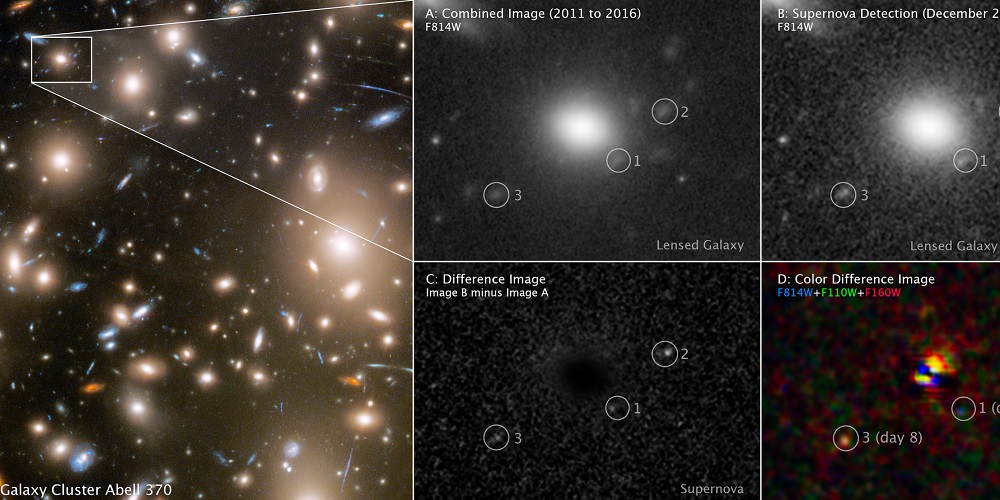User Rating: 5 / 5
Three distinct moments of a distant supernova explosion were captured simultaneously by the Hubble Space Telescope. The star exploded more than 11 billion years ago, when the universe was less than a fifth of its current age of 13.8 billion years. This is the first detailed look at a supernova early in the history of the universe.
The research could help scientists learn more about how stars and galaxies formed in the early universe. The supernova images are also special because they show the early stages of a starburst.
“It is very rare for a supernova to be detected at a very early stage because that stage is so short,” said Wenley Chen, lead author of the paper and a postdoctoral researcher in the University of Minnesota’s School of Physics and Astronomy. “It only lasts from hours to several days, and is easily missed even when detected up close. In the same shot, we can see a series of images, like the multiple faces of a supernova.”
This is made possible thanks to a phenomenon called gravitational lensing, which was first predicted in Einstein’s general theory of relativity. In this case, the massive gravity of galaxy cluster Abell 370 was a cosmic lens, deflecting and amplifying light from the most distant supernova.
The deformation also produced multiple images of the explosion at different time intervals, all of which reached Earth at once and were captured in a single Hubble image. This was only possible because the magnified images took different paths through the cluster, due to differences in the length of the paths that light took from the supernova, and because of the slowing of time and the curvature of space due to gravity.
The Hubble exposure also captured the rapid color change of the fading supernova, indicating a change in temperature. The bluer the color, the hotter the supernova. The first stage is blue. As the supernova cooled, its light turned red. “You see different colors in the three different images,” said Patrick Kelly, study leader and assistant professor in the University of Minnesota’s School of Physics and Astronomy. “You have a massive star, the core collapses, it shocks, it heats up, and then you watch it cold for a week. This is probably one of the most amazing things I’ve ever seen!”
This is also the first time that astronomers have been able to measure the size of a dying star in the early universe. This was based on the supernova’s brightness and cooling rate, both of which depend on the size of the star that gave birth to it. Hubble’s observations show that the red giant that scientists detected in the researchers’ supernova explosion was about 500 times the size of the Sun.
Chen, Kelly and an international team of astronomers discovered this supernova by sifting through archives of Hubble data for transient events. Chen wrote machine learning algorithms to find these events, but this was the only supernova identified with multiple images.
Chen and Kelly set a time limit for NASA’s James Webb Space Telescope to observe more distant supernovae. They hope to contribute to a catalog of very distant supernovae to help astronomers understand whether stars that have existed several billion years ago are different from those in the nearby universe.
The Hubble Space Telescope is an international collaborative project between NASA and the European Space Agency. NASA’s Goddard Space Flight Center in Greenbelt, Maryland, operates the telescope. The Space Telescope Science Institute (STScI) in Baltimore conducts the science activities for the Hubble Telescope. STScI is managed for NASA by the Consortium of Universities for Research in Astronomy in Washington, DC
source: NASA

“Thinker. Coffeeaholic. Award-winning gamer. Web trailblazer. Pop culture scholar. Beer guru. Food specialist.”







More Stories
Comet Tsuchinshan-Atlas is ready to shine this fall
Sonos isn’t bringing back its old app after all
Indiana Jones and the Great Circle is coming to PS5 in spring 2025